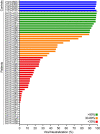Humoral immunity against SARS-CoV-2 variants including omicron in solid organ transplant recipients after three doses of a COVID-19 mRNA vaccine
- PMID: 35505864
- PMCID: PMC9052011
- DOI: 10.1002/cti2.1391
Humoral immunity against SARS-CoV-2 variants including omicron in solid organ transplant recipients after three doses of a COVID-19 mRNA vaccine
Abstract
Objectives: Solid organ transplant recipients (SOTR) receiving post-transplant immunosuppression show increased COVID-19-related mortality. It is unclear whether an additional dose of COVID-19 vaccines can overcome the reduced immune responsiveness against severe acute respiratory syndrome coronavirus 2 (SARS-CoV-2) variants.
Methods: We analysed humoral immune responses against SARS-CoV-2 and its variants in 53 SOTR receiving SARS-CoV-2 vaccination.
Results: Following the initial vaccination series, 60.3% of SOTR showed no measurable neutralisation and only 18.9% demonstrated neutralising activity of > 90%. More intensive immunosuppression, antimetabolites in particular, negatively impacted antiviral immunity. While absolute IgG levels were lower in SOTR than controls, antibody titres against microbial recall antigens were higher. By contrast, SOTR showed reduced vaccine-induced IgG/IgA antibody titres against SARS-CoV-2 and its delta variants and fewer linear B-cell epitopes, indicating reduced B-cell diversity. Importantly, a third vaccine dose led to an increase in anti-SARS-CoV-2 antibody titres and neutralising activity across alpha, beta and delta variants and to the induction of anti-SARS-CoV-2 CD4+ T cells in a subgroup of patients analysed. By contrast, we observed significantly lower antibody titres after the third dose with the omicron variant compared to the ancestral SARS-CoV-2 and the improvement in neutralising activity was much less pronounced than for all the other variants.
Conclusion: Only a small subgroup of solid organ transplant recipients is able to generate functional antibodies after an initial vaccine series; however, an additional vaccine dose resulted in dramatically improved antibody responses against all SARS-CoV-2 variants except omicron where antibody responses and neutralising activity remained suboptimal.
Keywords: COVID‐19; SARS‐CoV‐2; antibody responses; omicron variant; solid organ transplant; vaccine.
© 2022 The Authors. Clinical & Translational Immunology published by John Wiley & Sons Australia, Ltd on behalf of Australian and New Zealand Society for Immunology, Inc.
Conflict of interest statement
The authors declare no conflict of interest.
Figures






Similar articles
-
Delayed and Attenuated Antibody Responses to Coronavirus Disease 2019 Vaccination With Poor Cross-Variant Neutralization in Solid-Organ Transplant Recipients-A Prospective Longitudinal Study.Open Forum Infect Dis. 2023 Aug 10;10(8):ofad369. doi: 10.1093/ofid/ofad369. eCollection 2023 Aug. Open Forum Infect Dis. 2023. PMID: 37577118 Free PMC article.
-
Neutralizing antibody response against the B.1.617.2 (delta) and the B.1.1.529 (omicron) variants after a third mRNA SARS-CoV-2 vaccine dose in kidney transplant recipients.Am J Transplant. 2022 Jul;22(7):1873-1883. doi: 10.1111/ajt.17054. Epub 2022 Apr 18. Am J Transplant. 2022. PMID: 35384272 Free PMC article.
-
Humoral immune response after different SARS-CoV-2 vaccination regimens.BMC Med. 2022 Jan 21;20(1):31. doi: 10.1186/s12916-021-02231-x. BMC Med. 2022. PMID: 35057798 Free PMC article.
-
Insight into SARS-CoV-2 Omicron variant immune escape possibility and variant independent potential therapeutic opportunities.Heliyon. 2023 Feb;9(2):e13285. doi: 10.1016/j.heliyon.2023.e13285. Epub 2023 Jan 31. Heliyon. 2023. PMID: 36744070 Free PMC article. Review.
-
Update on Covid-19: vaccines, timing of transplant after COVID-19 infection and use of positive donors.Curr Opin Organ Transplant. 2023 Apr 1;28(2):76-84. doi: 10.1097/MOT.0000000000001056. Epub 2023 Feb 15. Curr Opin Organ Transplant. 2023. PMID: 36809306 Free PMC article. Review.
Cited by
-
Inefficient Induction of Neutralizing Antibodies against SARS-CoV-2 Variants in Patients with Inflammatory Bowel Disease on Anti-Tumor Necrosis Factor Therapy after Receiving a Third mRNA Vaccine Dose.Vaccines (Basel). 2022 Aug 11;10(8):1301. doi: 10.3390/vaccines10081301. Vaccines (Basel). 2022. PMID: 36016189 Free PMC article.
-
Comparison of humoral immunogenicity in solid organ transplant recipients after third-dose mRNA vaccine with homologous or heterologous schedules: An observational study.J Clin Virol. 2023 Feb;159:105374. doi: 10.1016/j.jcv.2022.105374. Epub 2022 Dec 30. J Clin Virol. 2023. PMID: 36592547 Free PMC article.
-
SARS-CoV-2 BA.2 (Omicron) variant infection in pediatric liver transplanted recipients and cohabitants during 2022 Shanghai outbreak: a prospective cohort.Virol J. 2023 Feb 11;20(1):28. doi: 10.1186/s12985-023-01978-4. Virol J. 2023. PMID: 36774503 Free PMC article.
-
Previous SARS-CoV-2 infection or a third dose of vaccine elicited cross-variant neutralising antibodies in vaccinated solid-organ transplant recipients.Clin Transl Immunology. 2022 Aug 11;11(8):e1411. doi: 10.1002/cti2.1411. eCollection 2022. Clin Transl Immunology. 2022. PMID: 35979345 Free PMC article.
-
Delayed and Attenuated Antibody Responses to Coronavirus Disease 2019 Vaccination With Poor Cross-Variant Neutralization in Solid-Organ Transplant Recipients-A Prospective Longitudinal Study.Open Forum Infect Dis. 2023 Aug 10;10(8):ofad369. doi: 10.1093/ofid/ofad369. eCollection 2023 Aug. Open Forum Infect Dis. 2023. PMID: 37577118 Free PMC article.
References
LinkOut - more resources
Full Text Sources
Research Materials
Miscellaneous
